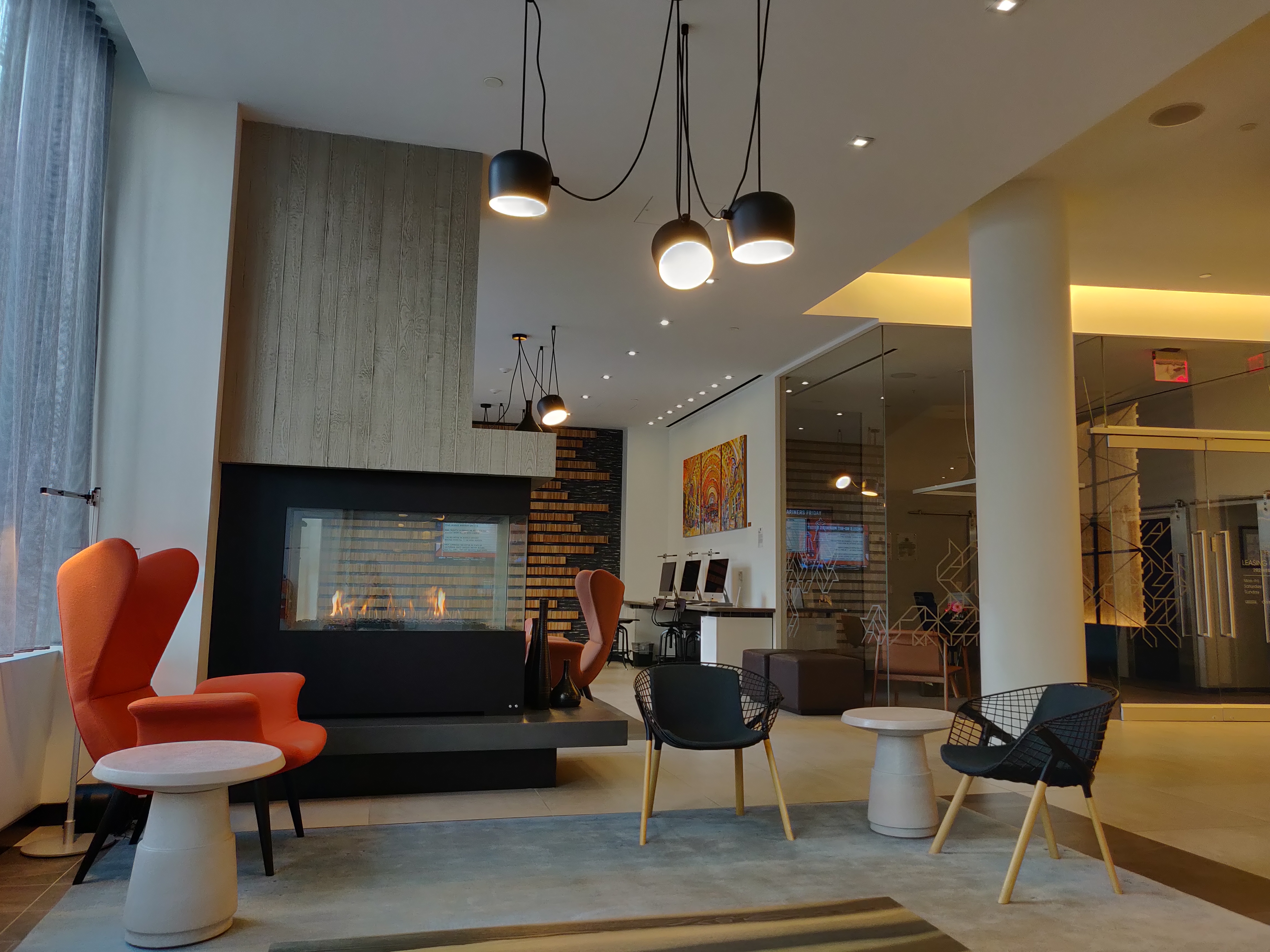|
Singapore Conference Hall
The Singapore Conference Hall is a multipurpose building located in the heart of the financial district of Shenton Way in Downtown Core of Singapore. The first building to be constructed along Shenton Way, it was a place for conferences and exhibitions in the 1960s and 1970s. Today, it is refurbished and modernised into a concert hall, home to the Singapore Chinese Orchestra since 2001. Completed in 1965 at a cost of S$4 million at that time, it was an example of the nation's urban architecture then. The building is situated on a three-acre site at the junction of Shenton Way and Maxwell Road. It was gazetted as a national monument on 28 December 2010. History During the 1959 general election, the People’s Action Party proposed a headquarters for the trade unions as part of its five-year plan for Singapore. A site on Armenian Street, formerly Saint Andrew's School, was initially chosen in 1960, but a larger site along Shenton Way was chosen instead in 1961. In June 1961 ... [...More Info...] [...Related Items...] OR: [Wikipedia] [Google] [Baidu] |
Shenton Way
Shenton Way is a major trunk road serving Singapore's Central Area and is most commonly known for the commercial skyscrapers flanking both sides of the road. The road is a one-way street that starts at the junction of Boon Tat Street, Raffles Quay and Commerce Street before ending at Keppel Road. History In January 1948, the Singapore government announced a development scheme in the Telok Ayer reclamation area, consisting of the development of of state land and the extension of Raffles Quay from Boon Tat Street to Prince Edward Road. The construction of the Raffles Quay extension was also recommended to the government in a special committee's report in September 1948, to improve connectivity between the central area and the harbour and to allow for the development of reclaimed land between Tanjong Pagar and Finalyson Green. Work on the extension's first phase between Raffles Quay and Prince Edward Road had commenced by December 1950, while construction of the second phase link ... [...More Info...] [...Related Items...] OR: [Wikipedia] [Google] [Baidu] |
Saint Andrew's School, Singapore
St. Andrew's School (abbreviation: SA) is a family of schools in Singapore, affiliated to each other as well as to the Anglican Diocese of Singapore. It comprises St. Andrew's Junior School (SAJS), St. Andrew's Secondary School (SASS) and St. Andrew's Junior College (SAJC). The schools are often referred to aThe Saints' Family Together, the three schools offer primary, secondary and pre-university education (otherwise known as Grades 1 to 12), having an enrolment of 4000 to 5000 students. SAJS and SASS are located in the Woodsville Campus, while SAJC is located across the Kallang River in the Potong Pasir Campus. Both campuses are linked to each other by the Jacob Ballas Bridge, forming St Andrew's Village (SAV). The junior and secondary schools have always only admitted male pupils, but female pupils were admitted to the pre-university or 'A' level classes when they were run from the senior school previously. St Andrew's Junior College has always been co-educational since be ... [...More Info...] [...Related Items...] OR: [Wikipedia] [Google] [Baidu] |
Architects Team 3
An architect is a person who plans, designs and oversees the construction of buildings. To practice architecture means to provide services in connection with the design of buildings and the space within the site surrounding the buildings that have human occupancy or use as their principal purpose. Etymologically, the term architect derives from the Latin ''architectus'', which derives from the Greek (''arkhi-'', chief + ''tekton'', builder), i.e., chief builder. The professional requirements for architects vary from place to place. An architect's decisions affect public safety, and thus the architect must undergo specialized training consisting of advanced education and a ''practicum'' (or internship) for practical experience to earn a license to practice architecture. Practical, technical, and academic requirements for becoming an architect vary by jurisdiction, though the formal study of architecture in academic institutions has played a pivotal role in the development of the ... [...More Info...] [...Related Items...] OR: [Wikipedia] [Google] [Baidu] |
Performance
A performance is an act of staging or presenting a play, concert, or other form of entertainment. It is also defined as the action or process of carrying out or accomplishing an action, task, or function. Management science In the work place, job performance is the hypothesized conception or requirements of a role. There are two types of job performances: contextual and task. Task performance is dependent on cognitive ability, while contextual performance is dependent on personality. Task performance relates to behavioral roles that are recognized in job descriptions and remuneration systems. They are directly related to organizational performance, whereas contextual performances are value-based and add additional behavioral roles that are not recognized in job descriptions and covered by compensation; these are extra roles that are indirectly related to organizational performance. Citizenship performance, like contextual performance, relates to a set of individual activity/co ... [...More Info...] [...Related Items...] OR: [Wikipedia] [Google] [Baidu] |
Party
A party is a gathering of people who have been invited by a host for the purposes of socializing, conversation, recreation, or as part of a festival or other commemoration or celebration of a special occasion. A party will often feature food and beverages, and often conversation, music, dancing, or other forms of entertainment. Some parties are held in honor of a specific person, day, or event, such as a birthday party, a Super Bowl party, or a St. Patrick’s Day party. Parties of this kind are often called celebrations. A party is not necessarily a private occasion. Public parties are sometimes held in restaurants, pubs, beer gardens, nightclubs, or bars, and people attending such parties may be charged an admission fee by the host. Large parties in public streets may celebrate events such as Mardi Gras or the signing of a peace treaty ending a long war. Types Balls Banquets Birthday party A birthday party is a celebration of the anniversary of the birth of ... [...More Info...] [...Related Items...] OR: [Wikipedia] [Google] [Baidu] |
Lobby (room)
A lobby is a room in a building used for entry from the outside. Sometimes referred to as a foyer, reception area or an entrance hall, it is often a large room or complex of rooms (in a theatre, opera house, concert hall, showroom, cinema, etc.) adjacent to the auditorium. It may be a repose area for spectators, especially used before performance and during intermissions, but also as a place of celebrations or festivities after performance. Since the mid-1980s, there has been a growing trend to think of lobbies as more than just ways to get from the door to the elevator but instead as social spaces and places of commerce. Some research has even been done to develop scales to measure lobby atmosphere to improve hotel lobby design. Many office buildings, hotels and skyscrapers go to great lengths to decorate their lobbies to create the right impression and convey an image. [...More Info...] [...Related Items...] OR: [Wikipedia] [Google] [Baidu] |
Concourse
A concourse is a place where pathways or roads meet, such as in a hotel, a convention center, a railway station, an airport terminal, a hall, or other space. The term is not limited to places where there are literally pathways or roadways or train tracks joining. An alternate meaning now is "an open space or hall (as in a railway terminal) where crowds gather." In this meaning as a place where crowds gather, while many persons in any crowd no doubt have followed different paths in their lives to get to the place, there need not be notable specific roadways leading to the place. Examples Examples of concourses include: * Meeting halls * Universities * Railway stations * Conference centres * Hotels * Airport terminals * Shopping malls or portions of shopping malls which are often called "shopping concourses" * Sports arenas and stadiums Gallery Outdoor concourses Image:Earnley concourse West Sussex.jpg, Earnley Concourse, West Sussex, 2009This local village name for it ... [...More Info...] [...Related Items...] OR: [Wikipedia] [Google] [Baidu] |
Sunscreen
Sunscreen, also known as sunblock or sun cream, is a photoprotective topical product for the skin that mainly absorbs, or to a much lesser extent reflects, some of the sun's ultraviolet (UV) radiation and thus helps protect against sunburn and most importantly prevent skin cancer. Sunscreens come as lotions, sprays, gels, foams (such as an expanded foam lotion or whipped lotion), sticks, powders and other topical products. Sunscreens are common supplements to clothing, particularly sunglasses, sunhats and special sun protective clothing, and other forms of photoprotection (such as umbrellas). The first sunscreen in the world was invented in Australia, by chemist H.A. Milton Blake, in 1932 formulating with the UV filter 'salol' (phenyl salicylate) at a concentration of 10%. Its protection was verified by the University of Adelaide and it was also produced commercially by Blake's company, Hamilton Laboratories. Despite sunscreen being relatively new, sun protection practices ha ... [...More Info...] [...Related Items...] OR: [Wikipedia] [Google] [Baidu] |
Glass
Glass is a non-crystalline, often transparent, amorphous solid that has widespread practical, technological, and decorative use in, for example, window panes, tableware, and optics. Glass is most often formed by rapid cooling (quenching) of the molten form; some glasses such as volcanic glass are naturally occurring. The most familiar, and historically the oldest, types of manufactured glass are "silicate glasses" based on the chemical compound silica (silicon dioxide, or quartz), the primary constituent of sand. Soda–lime glass, containing around 70% silica, accounts for around 90% of manufactured glass. The term ''glass'', in popular usage, is often used to refer only to this type of material, although silica-free glasses often have desirable properties for applications in modern communications technology. Some objects, such as drinking glasses and eyeglasses, are so commonly made of silicate-based glass that they are simply called by the name of the material. Despite bei ... [...More Info...] [...Related Items...] OR: [Wikipedia] [Google] [Baidu] |
Concrete
Concrete is a composite material composed of fine and coarse aggregate bonded together with a fluid cement (cement paste) that hardens (cures) over time. Concrete is the second-most-used substance in the world after water, and is the most widely used building material. Its usage worldwide, ton for ton, is twice that of steel, wood, plastics, and aluminum combined. Globally, the ready-mix concrete industry, the largest segment of the concrete market, is projected to exceed $600 billion in revenue by 2025. This widespread use results in a number of environmental impacts. Most notably, the production process for cement produces large volumes of greenhouse gas emissions, leading to net 8% of global emissions. Other environmental concerns include widespread illegal sand mining, impacts on the surrounding environment such as increased surface runoff or urban heat island effect, and potential public health implications from toxic ingredients. Significant research and development is ... [...More Info...] [...Related Items...] OR: [Wikipedia] [Google] [Baidu] |
National Trades Union Congress
The National Trades Union Congress (NTUC), also known as the Singapore National Trades Union Congress (SNTUC) internationally, is the sole national trade union centre in Singapore. NTUC is at the heart of the Labour Movement which comprises 59 affiliated trade unions, 5 affiliated trade associations, 10 social enterprises, 6 related organisations as well as a growing ecosystem of U Associates and enterprise partners. Together, it helms May Day celebrations and organises an annual rally in support of workers' solidarity and commitment to tripartite partnership. The NTUC has had a symbiotic relationship with the People's Action Party (PAP) since its inception in 1961. History The NTUC was established in 1961 when the Singapore Trades Union Congress (STUC), which had backed the People's Action Party (PAP) in its successful drive for self-government, split into the pro-PAP NTUC and the leftist Singapore Association of Trade Unions (SATU). The SATU collapsed in 1963, following the g ... [...More Info...] [...Related Items...] OR: [Wikipedia] [Google] [Baidu] |








